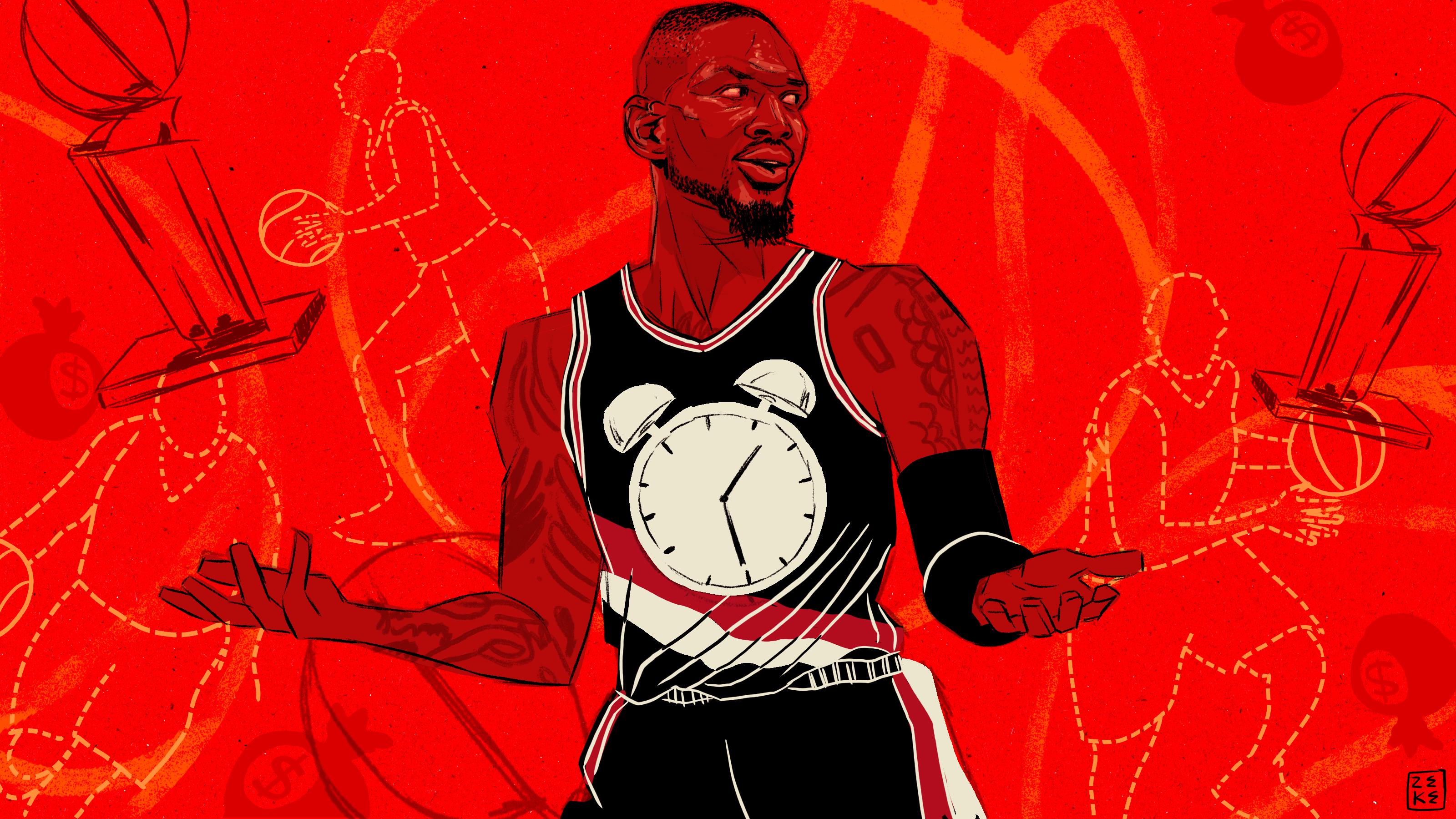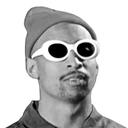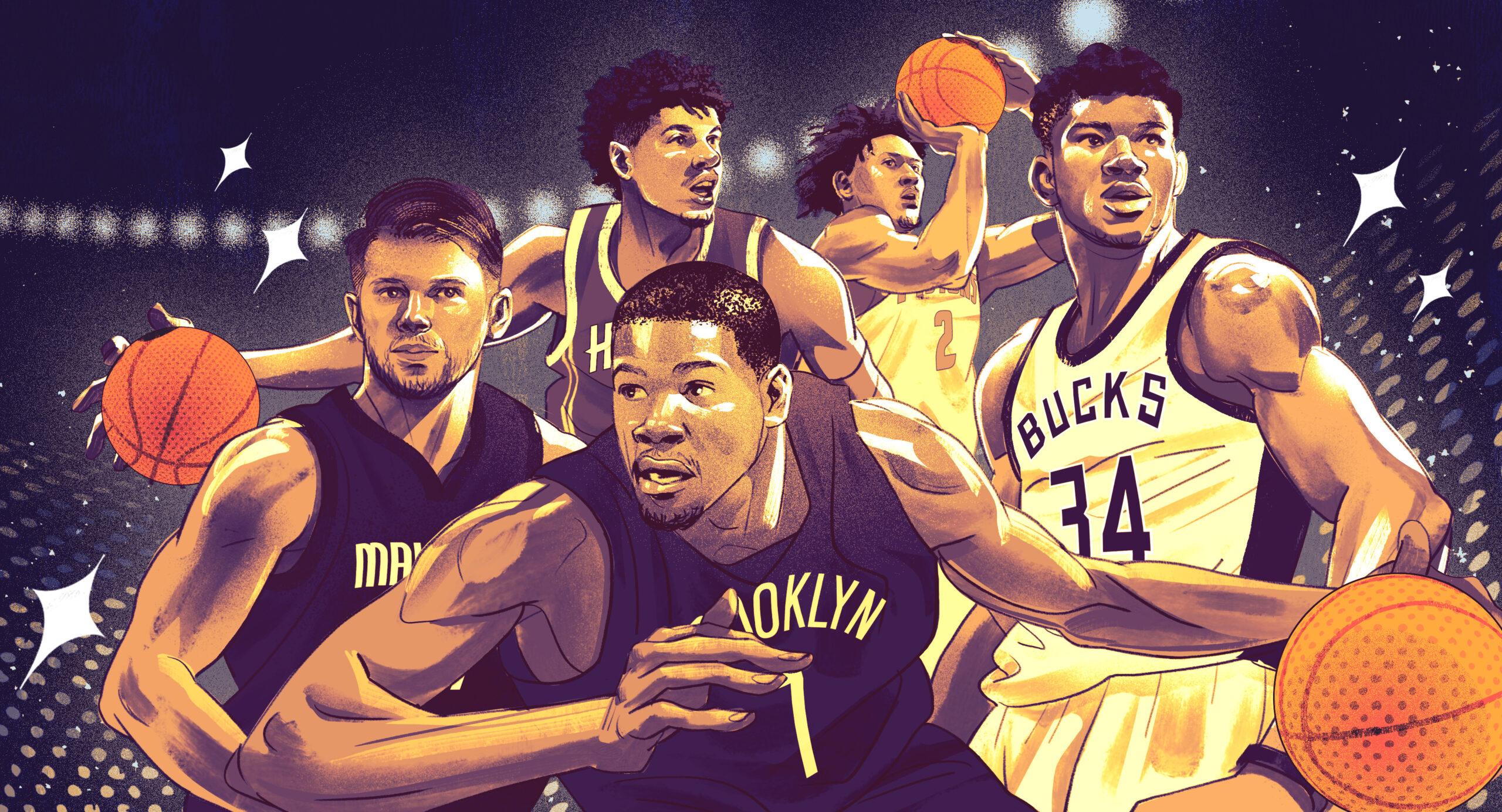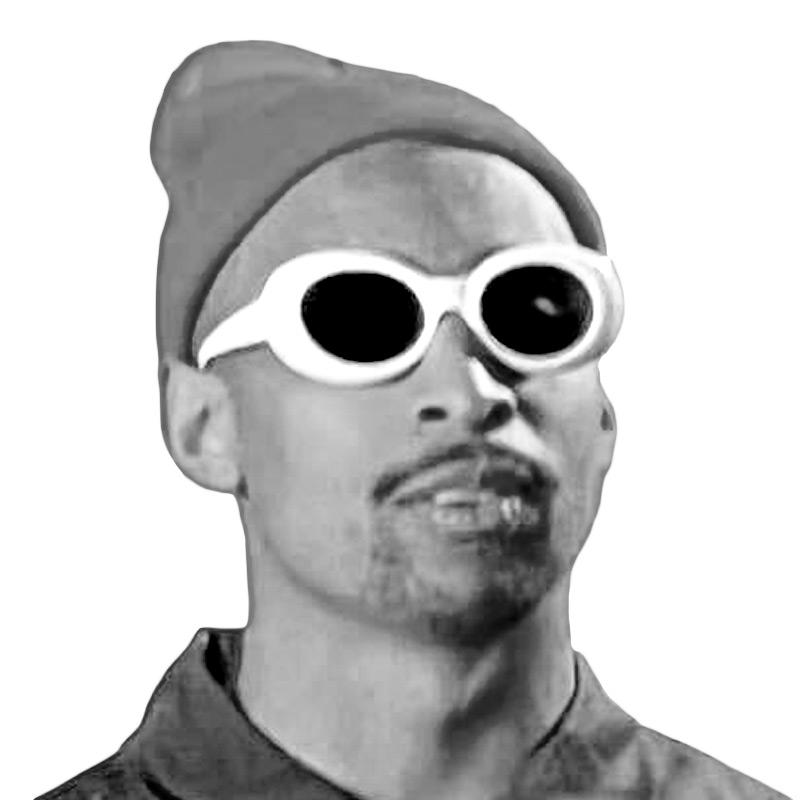Dame Is Doing It His Way
The Trail Blazers star had a chance to jump ship and join a superteam like most of his peers. Instead, he decided to stay in Portland and build a new winner in his image.Damian Lillard was sitting at a table at LeBron James’s mansion, with the biggest decision of his career in front of him.
It was the summer of 2021, and Lillard was in Los Angeles to shoot a music video. The day before, he had run into James on the baseline at a midseason WNBA game between the Aces and Sparks. A month prior, Lillard’s Portland Trail Blazers had been eliminated in the first round for the second straight season, leaving the guard uncertain about his future with the franchise. James had suffered an early playoff exit himself, and was looking to recruit a star guard to Los Angeles. Ever the salesman, he extended Lillard an invitation to his sprawling Brentwood estate.
“He was just like, ‘Pull up to the house,’” Lillard told me recently. “And I’m like, shit, I’m out here. Tomorrow is the only day I ain’t got nothing planned out. I can pull up for a little bit.”
Now Lillard was seated across from James and Anthony Davis, who needed help in their quest for another title. That evening, they indulged in expensive wine and Italian cuisine and discussed their plans for the future. “We just chopped it up just about the possibilities,” Lillard said.
“What’s going on with you?” Lillard said James asked him.
“And I was like, ‘I really don’t know what we’re doing,’” Lillard said. “It was just a conversation like that.”
“I wasn’t even looking at it like a recruiting process,” he added. “The whole time I was like, ‘I play for the Blazers.’ My only point is, let’s give ourselves a chance. I wasn’t sending no shots or sending no threats. I’m just honest. When I get asked a question, I answer the question. Because these questions had never been asked.”
James’s decision 12 years ago to join the Miami Heat spearheaded a historic era of superstar player movement. Stars like James, Davis, and Kevin Durant left the teams that drafted them for so-called “superteams” in an effort to win titles. It also caused an increase in trade requests, as players looked to team up with other stars currently under contract. The paradigm shift increased intrigue in free agency, and, according to Lillard, distorted expectations for star players.
“I think what’s causing a lot of the movement is the pressure that’s being put on players and athletes,” he said. “About, ‘Oh, he don’t have a ring,’ and they almost make it seem like you just didn’t do shit because you didn’t win a ring. You got people out there like Charles Barkley and Patrick Ewing, Reggie Miller—these dudes is legends. Come on, man, you can’t take nothing away because they didn’t win a championship.”
Lillard had become the poster child for staying put, signing two extensions with the Trail Blazers totaling more than $300 million. “People make a joke out of it sometimes, like, ‘Man, he’s too loyal, he don’t want to win, he just want his money,’” he said. “I don’t take nothing away from those guys. I think a lot of times because of my stance on it, people try to put my stance on it as if I’m belittling or I’m saying something bad about the guys that do move. And I’m not. I’m just standing on my square about what I believe. They can do whatever they want; if that’s what makes them happy, then do it.”
But after the Blazers lost to the Denver Nuggets in the first round of the 2021 postseason, even though Lillard averaged over 34 points and 10 assists a game, he became disillusioned with the direction of the franchise.
“It just had reached the point where I was like, ‘Is what I want the same as what the organization wants?’” Lillard told me recently. “Do we actually want to win, or is it a situation where, ‘We’re going to be good enough, we know Dame is going to put his best foot forward and it’s going to be entertaining, we’re going to be competitive, we’re going to have a chance in the playoffs.’”
After years of stagnation, including four first-round exits wrapped around a trip to the 2019 West finals, Lillard was open to seeing what the rest of the league had to offer. And for a moment at LeBron’s table, the Lakers duo was making a compelling case for Lillard to leave, enough to form a fleeting idea of donning the purple and gold. “I mean, of course I thought about it,” Lillard said. “Like, man, what if that happened? What if I did go? I thought about it. At that point, I was thinking about a lot of things.”
Lillard added: “I was like, ‘If I’m going to ever look at a different situation than mine, I’m going to look at one where I know I’m going to have a great chance to win.’”
But as the evening progressed, lessons learned from childhood began to overtake any urge he had to jump ship.
“The way I look at it is I grew up in that type of environment: You got to be for your family, you got to be for your people,” he told me. “That’s just what my family stood for. My dad, my mom, my brother, my cousins, and my grandparents, uncles, aunties: I’ve seen plenty of my family members have arguments and disagreements. There might have been a fight or whatever, but we were like this. Still, this to this day. So all I know is to roll with your own. Roll with your people.”
By the end of the night, Lillard had a clearer picture of his future.
“I want to win as a Trail Blazer,” Lillard said. “I want to win a championship where I am. I don’t think I would feel the same joy and happiness if I did it elsewhere. I would be happy, no doubt. Like winning a chip, you get that experience.
“But I know how I want it.”
Early in his career, Lillard would occasionally venture into the office of Joe Cronin. Cronin joined the Blazers as a basketball operations intern in 2006, and was a pro scout by the time Lillard was drafted in 2012. During Lillard’s visits, the two would discuss prospects and disappointment in their Raiders.
“He just watches and is curious and he has such a good scout mind,” Cronin told me. “A good front-office mind and mentality that he just follows all that stuff. He’s just so intimately curious about basketball and basketball players. So that was just such a natural way for us to get to know each other and to talk and communicate.”
But in January 2022, Lillard sat across from his old pal and new head coach Chauncey Billups and asked a more pointed question: “What are we doing?”
Neil Olshey, the general manager who drafted Lillard, had been fired in the wake of reports that he had created a toxic work environment, including “profanity-laced tirades” toward staff members. Lillard, 32, was out with a core injury that he’d been playing through for the past four years and would later require surgery, and the Blazers were sputtering, spending most of the season near the bottom of the Western Conference standings.
After his visit to James’s crib six months earlier, Lillard, with three years left on his contract, traveled to Cabo for a brief vacation and placed a call to Olshey, Blazers owner Jody Allen, and team vice chair Bert Kolde and reaffirmed his commitment to Portland.
But following Olshey’s firing, Lillard needed assurances from Cronin, now the interim general manager, that the organization still prioritized winning.
In response, Billups asked him to see the bigger picture.
“The biggest message that I wanted to send to Dame,” Billups told me, “was that this thing needs to be built around making sure we bring people around that can actually help him be better.”
Billups, in his first year as a head coach, also has had a relationship with Lillard for more than a decade. In 2014, during Billups’s final year in Detroit, the Pistons took a trip West to play Portland. Jared Jeffries told Billups, then near the end of his career, to watch out for the kid from Oakland. “He was like, ‘I got your twin, bro. This dude is your twin,’” Billups said. “Y’all play, y’all act alike. This is your twin.”
“And obviously I had heard about him,” Billups continued. “And I seen he had been killing. He was balling. So I was like, ‘Man, I’m going to really lock in on him.’”
Billups would send congratulatory texts after big games and offer pointers. When the Blazers lost Game 5 to Denver in the 2019 Western Conference semifinals, falling behind 3-2 in the series, Billups, then a TV analyst, sought out Lillard in an arena hallway. “I saw him in the back and he was like, ‘Hey, man, this is it right here,’” Lillard said. “He almost got at me like, ‘You got to come on with it. Y’all facing elimination.’ I deal best with people that are straight to the point.” Lillard dropped 32 points in Game 6, a Portland win, then overcame a poor shooting night to post a near triple-double on the road in Game 7, sealing the first Western Conference finals berth of his career.
But in the January meeting, with a chance to pitch his plans for the future, Billups took a different approach.
“I told myself, and I told Dame this before I got the job: ‘I ain’t recruiting you.’ I’m going to tell you what I feel and what I think because I care about the person,” Billups said. “You got decisions you have to make for you and your own family. I can tell you what I think I can do to help you, but I ain’t coming with no recruiting pitch, I ain’t gonna do that. Because a lot of times, lying has a lot to do with recruiting; I’m not going to do that. I was no different at that point than I was before I got the job. I just tried to keep it real with him.”
Said Lillard: “That’s why I fuck with him so heavy. He knows the game, he’s a thinker, he’s a players’ coach, he has relationships with everybody, but I know he’s going to keep it solid.”
By the end of the meeting, Lillard had been persuaded to stick around for a while.
“We just got in line with each other,” he said. “I didn’t know exactly what they was going to do but they was like, ‘We’re going to put our heads together and we going to make some stuff happen. We going to start building this thing in a direction to where we have options and we can go get some guys, we can get some talent, we can get some young guys, we can have some picks.’ It was just, we got on the same page about what it was going to look like going forward.”
But looking forward meant parting with the past. CJ McCollum had been by Lillard’s side every season since his sophomore year, experiencing all the ups and the downs—and the many, many trade rumors.
“Over the years, we’d be struggling, a slow start, and we would be like, ‘One of us is going to be traded. I’m going to get traded,’” Lillard said. “Then so many years went by that I just stopped even thinking about it. Like, it won’t happen.”
But the Blazers were looking to get under the luxury tax threshold, and with the emergence of Anfernee Simons, a deal was imminent.
Lillard was aware of McCollum’s pending departure. “We definitely knew in advance,” he said. “It really was a matter of them getting a deal done.” But Lillard didn’t want specifics ahead of time. “Neil used to tell me, ‘If anything comes up, I don’t want you to be in a position where you know and you can’t say something, because I know of your friendships with some of the guys on the team,’” Lillard said.
On the morning of February 8, 2022, the duo was finally broken up. McCollum was shipped to New Orleans for Josh Hart, three other players, and a handful of draft picks. Five months later, Lillard signed a two-year extension worth $122 million, including a $63 million player option for 2026-27, when Lillard will be 36. His road dog was gone, and a new era was on the horizon.
“I think with him and CJ, they’re brothers, and I think they both knew at some point they was going to have to split,” Billups said. “If you wanted more, I was going to try it a different way. They had really pretty much maxed it out, just them two.”
Last year, while playing in the Summer Olympics, Lillard was so impressed by Team USA teammate Jerami Grant that he plotted a plan to steal him from the Detroit Pistons.
The über-athletic forward had signed a three-year, $60 million deal with the Pistons in the 2020 offseason to prove he was capable of more than the defensive specialist role that he’d earned in Denver. In his first season in Detroit, he did just that, averaging 22.3 points and 4.6 rebounds. But Grant was ready to do the same for a winning team. Enamored of Grant’s talent, and aware of his work conundrum, Lillard prepared a blunt pitch. “Bro, if they’re not trying to win and then you decide that you going to leave, tell them to trade you to Portland,” he’d say.
Three months after his season wrapped, Grant was traded to the Blazers. “I’m definitely someone who could help him to win it all,” Grant said recently. “I’m very comfortable with that.”
The trade for Grant was a clear sign that the Blazers would follow Lillard’s lead into their next era, but it also showed how this new vision differed from the last. Lillard and McCollum powered a high-octane offense for years, but Portland’s defense rarely could keep up. The Blazers finished 29th in defensive rating the past two seasons, and in the NBA’s bottom half the two seasons before that.
So when the luxury tax kept the Warriors from paying defensive stopper Gary Payton II, Lillard worked the phones. “He knew that [Portland] was going to have some money and then he was just like, ‘I think we can be able to do it financially,’” Payton said.
But there will still be plenty of offense, too. When Simons was drafted in 2018, Lillard had visions of the then-19-year-old sharing a backcourt with him and McCollum. “We got a major talent,” Lillard said. “He was young but he got all the skills that can play with us. We don’t have to have someone with responsibility handling the ball. And he’s the right type of person. He works hard, he’s a good dude, he’s a team player, quiet, unselfish but confident, and I just believed in him.”
When growing pains arose, Lillard and McCollum would reassure the young’un. “Don’t change it based off your success, or if you’re not succeeding,” they’d say, according to Simons. “No matter how much success you get, still be the same person, as if you are still trying to make it to hoop where you are today.”
Simons described Lillard and McCollum as “probably the guys that introduced me to how to be a good guard in the league,” Simons said. It all paid off after the new year last season, when Simons averaged 23 points and six assists a game, including nights when he went off for 43 and 38 points.
Now the starter next to Lillard in the backcourt, Simons signed an extension this offseason that will pay him $100 million over four years. A week later, Jusuf Nurkic, another Lillard favorite, signed a four-year pact worth $70 million. With the no. 7 pick in the draft, Portland drafted Shaedon Sharpe, another 19-year-old with immense promise.
“I think we just got to keep building toward winning it all,” Lillard said.
As Portland plans for the future, ownership issues loom. Last winter, reports emerged that Phil Knight, the founder of Nike, is interested in buying the team. Jody Allen, who took over the team after the death of her brother Paul Allen in 2018, released a statement saying that neither the Blazers nor the Seattle Seahawks, which Allen also owns, are for sale. However, within that statement, Allen did acknowledge that there will be “a time when that changes,” albeit not over a “pre-ordained timeline.” Lillard is taking a wait-and-see approach.
“That’s out of my control,” Lillard said. “At this point in my career if there’s something I can’t control I ain’t wasting my time with it.”
Last season was the worst in Lillard’s decade in Portland, but it did give him time to reassess what’s important as he enters the next stretch of his career. When abdominal surgery ended his season last winter, Lillard retreated home and enjoyed a luxury that NBA players rarely experience. “Being at home with my family, my kids, and my wife. Being around my mom, and just going to my nephew’s football games, and traveling, and shit like that,” he said. “Just getting that family time in. I was just able to fill my cup, do the stuff that I never get to do, and just be present with my kids. It just brought me a different type of happiness, and a different type of peace.”
Now, Lillard has everything he could want. It isn’t the typical path for players of Lillard’s caliber in the current climate, but it may be the one that suits him best.
“I love what we have,” he said. “We look really good on paper, the way things stack up. But when you put on the floor you gotta connect, we gotta be tapped in. How well we jell and how connected we are is ultimately gonna show that in our performance.”



